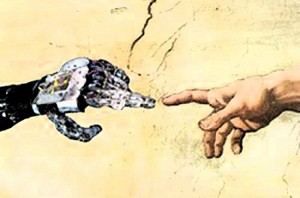In the book, The Architecture Machines written in 1969, Nicholas Negroponte proves to be a visionary propagating the school of machinic thought and digitisation in architecture.
The author begins the chapter questioning the credential of division of creative labour when machine is introduced not only to perform programmed function but also to find solutions in a given circumstance.
The aim is to develop an intelligent device.
A self improvising Evolutionary machine, a highly advanced mutated specie of current generation, that is capable of assimilating the architecture and its learning process. The union of designer and machine is so closely knit that the contribution of each becomes undistinguishable. The aim is to work as equals, thus rendering unique attributes of each towards a common goal.
An intelligent Learning machine that bears the characteristic of
a. A heuristic mechanism, an experience based solution,
b. Rote apparatus, a repetition based memorisation technique,
c. A conditioning device, a habitual method of problem solving,
d. A reward selector, to deduce rational conclusion,
e. A forgetting convenience, a capability of unlearning the obsolete processes in order to adapt to new ones.
The architecture machine is a unit in the whole network connected to each other and the designer through a parent machine. The parent machine is a warehouse of information and functions as a data store.
The analytical Seeing machine, which bears reflection of a designer and is able to assess the problem physically through its sensory organs, analyses its abstract parameters before translating the information into deliverables.
The dialogue between man and machine is very profound in the current scenario but the extent of interaction as envisioned by Negroponte is still remote. When a machine will reach this extent of intelligence as conceived by Negroponte, it shall be a revolution in human achievements.
Other authors have also investigated the machine and architecture under diverse perspectives. Negroponte’s line of thought differs vastly from Schumaker, who elaborates Parametriscism as a new style based on emulating nature or Deluze and De Landa, who extract the essence of their theory of origin and structural growth of the form from analytical and mathematical derivative. Similarly Johnson and Thompson too present their outlook oh emergence and growth of a system as a whole. These are deep seated philosophy that bears different analogy to each individual, and enlivens the design process when implemented. When Negroponte emphasises on machine as designer, he omits the purpose of architecture is not only to generate effective solutions but also to create atmospheres.
The research topic would be oriented towards the Symbiosis of buildings, exchanging the vitals for balanced sustainability, similar to nature, where the being is not contained to itself but gives the productive excess to the surrounding and vice versa. A building is not a unit but a part of a network where it imbibes and shares its energy thus increasing the efficiency of the chain as a whole.

